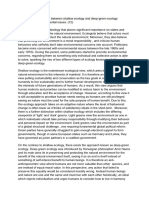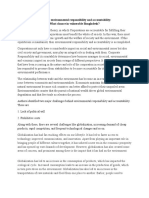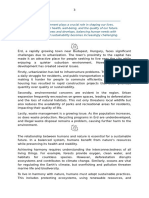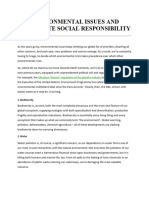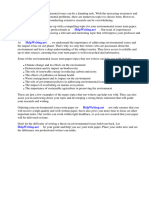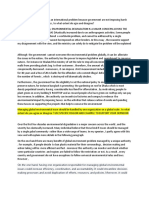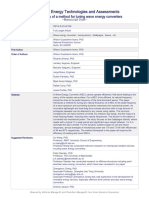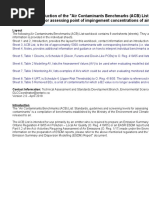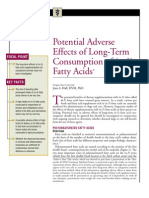Environmental Friendliness As A Marketing Strategy
Environmental Friendliness As A Marketing Strategy
Uploaded by
Hoih NgaihteCopyright:
Available Formats
Environmental Friendliness As A Marketing Strategy
Environmental Friendliness As A Marketing Strategy
Uploaded by
Hoih NgaihteOriginal Title
Copyright
Available Formats
Share this document
Did you find this document useful?
Is this content inappropriate?
Copyright:
Available Formats
Environmental Friendliness As A Marketing Strategy
Environmental Friendliness As A Marketing Strategy
Uploaded by
Hoih NgaihteCopyright:
Available Formats
ENVIRONMENTAL FRIENDLINESS AS A MARKETING STRATEGY
CHAPTER 1: OVERVIEW OF PRESENT ENVIRONMENT CONCERNS
The climate is changing. The earth is warming up, and there is now overwhelming scientific consensus that it is happening, and human-induced. With global warming on the increase and species and their habitats on the decrease, chances for ecosystems to adapt naturally are diminishing. Many are agreed that climate change may be one of the greatest threats facing the planet. Recent years show increasing temperatures in various regions, and/or increasing extremities in weather patterns.
Research has shown that air pollutants from fossil fuel use make clouds reflect more of the suns rays back into space. This leads to an effect known as global dimming whereby less heat and energy reaches the earth. At first, it sounds like an ironic savior to climate change problems. However, it is believed that global dimming caused the droughts in Ethiopia in the 1970s and 80s where millions died, because the northern hemisphere oceans were not warm enough to allow rain formation. Global dimming is also hiding the true power of global warming. By cleaning up global dimmingcausing pollutants without tackling greenhouse gas emissions, rapid warming has been observed, and various human health and ecological disasters have resulted, as witnessed during the European heat wave in 2003, which saw thousands of people die. The variety of life on Earth, its biological diversity, is commonly referred to as biodiversity. The number of species of plants, animals, and microorganisms, the enormous diversity of genes in these species, the different ecosystems on the planet, such as deserts, rainforests and coral reefs are all part of a biologically diverse Earth. Appropriate conservation and sustainable development strategies attempt to recognize this as being integral to any approach. In some way or form, almost all cultures have recognized the importance of nature and its biological diversity for their societies and have therefore understood the need to maintain it. Yet, power, greed and politics have affected the precarious balance
Biodiversity boosts ecosystem productivity where each species, no matter how small, all have an important role to play.
For example, a larger number of plant species means a greater variety of crops; greater species diversity ensures natural sustainability for all life forms; and healthy ecosystems can better withstand and recover from a variety of disasters.
It has long been feared that human activity is causing massive extinctions. Despite increased efforts at conservation, it has not been enough and biodiversity losses continue. The costs associated with deteriorating or vanishing ecosystems will be high. However, sustainable development and consumption would help avert ecological problems.
At the 1992 UN Conference on Environment and Development (the Earth Summit), the Convention on Biological Diversity (CBD) was born. 192 countries, plus the EU, are now Parties to that convention. In April 2002, the Parties to the Convention committed to significantly reduce the loss of biodiversity loss by 2010. Perhaps predictably, that did not happen. Despite numerous successful conservations measures supporting biodiversity, the 2010 biodiversity target has not been met at the global level. This page provides an overview on how the attempts to prevent biodiversity loss is progressing.
CHAPTER 2: INTRODUCTION
The United States plus a few other countries, and many large corporations, have been against climate change treaties due to the fear of the threat to their economy and profits if they have to make substantial changes.
However, as more climate change science has emerged over the years, many businesses are accepting this and even asking their governments for more action so that there is quick clarification on the new rules of the game so they can get on with their businesses. Many corporations and businesses are adopting green marketing and are being environmentally friendly so as to appeal to the masses and contribute to the society at the same time
NEWSWEEK's 2010 Green Rankings is a data-driven assessment of the largest companies in the U.S. and in the world. Our goal was to cut through the green chatter and quantify the actual environmental footprints, policies, and reputations of these big businesses. To do this, we teamed up with three leading environmental research organizations to create the most comprehensive rankings available. Who made the top 10? View our methodology.
Background: People are getting more aware of the environmental issues every day. One only have to read in a daily paper to realize to what extent todays society affect the environment, how the general public is becoming more aware of the problem and willing to do something about it.
The recent years large natural disasters and climate changes, such as hurricanes and severe floods, have elevated the general public of their impact on the environment. This is being displayed through great national attempts to create environmental protocols, reducing discharges and so forth. People are becoming inclined to give up some of their personal comfort in order to be more environmental friendly. This can be demonstrated through travelling by bus instead of by car, by saving electricity, by buying environmental friendly products and by supporting products and services that are produced locally in order to reduce waste even though those efforts might mean higher prices and less comfort.
This change in the awareness of the environment has led to a shift in the demand for environmental friendly products from the public. Many grocery stores today provide organic, toxic free products and so forth, as alternatives to the regular products, which can be seen as a result of the environmental awareness of people and the increased demand for healthier food.
Low price earlier often was a very important factor, issues such as how the item has been produced, what it contains and if there are any toxics or chemical additives in it has become determinant factors for a large group of people, whether to buy or not. However it should be said that even if the environmental issues are a concern, still the price is one of the most important determines for many people. Traditionally marketing has focused on the marketing mix and the four P:s of marketing, product, price, place and promotion. However a marketing approach focusing on creating customer value and relationships has attracted interest the last decades.
With all these aspects in mind it is interesting to further investigate how and if environmental friendliness can be used by the general dealers for marketing purposes. Can the environment and an approach signaling environmental consideration be used as a way to position a company and can it thereby be a strategic tool?
You might also like
- Atlas of Swept Source OCT (2017)Document179 pagesAtlas of Swept Source OCT (2017)Hang doNo ratings yet
- ASTM D696 Coeficiente de Expansão TérmicaDocument5 pagesASTM D696 Coeficiente de Expansão TérmicaEva SilvaNo ratings yet
- Fiitjee: Big Bang Edge Test - 2019Document21 pagesFiitjee: Big Bang Edge Test - 2019Sanjaya SahooNo ratings yet
- BAe 146 General Data BrochureDocument74 pagesBAe 146 General Data Brochuredanielprins100% (5)
- Consumerism QuestionsDocument12 pagesConsumerism QuestionsNursaeda MusaiyaNo ratings yet
- Importance of Environmentalism - GMDocument14 pagesImportance of Environmentalism - GMMoses PNo ratings yet
- Global Goal 12 Responsible Consumption and ProductionDocument6 pagesGlobal Goal 12 Responsible Consumption and ProductionCharlie IsidroNo ratings yet
- Environmental Protection Case StudyDocument8 pagesEnvironmental Protection Case StudyLouisse ValeriaNo ratings yet
- Naranzaya I.R.Document5 pagesNaranzaya I.R.wutever021No ratings yet
- STS Final CDocument16 pagesSTS Final CJosh OfficialNo ratings yet
- Review of Related LiteratureDocument13 pagesReview of Related LiteratureelynNo ratings yet
- RMT Report 1Document23 pagesRMT Report 1Mudasar RabaniNo ratings yet
- Environmental PoliticsDocument5 pagesEnvironmental PoliticsTripti TiwariNo ratings yet
- Changes and Rapid Development in Technology and It's Effects On The Environment. Depict Your Vision in The Form of An EssayDocument2 pagesChanges and Rapid Development in Technology and It's Effects On The Environment. Depict Your Vision in The Form of An EssaySoham NaikNo ratings yet
- Climate Change Example EssayDocument2 pagesClimate Change Example EssayHoàng Anh Kim ĐìnhNo ratings yet
- Examine The Differences Between Shallow Ecology and Deep-Green Ecology Approaches To Environmental IssuesDocument4 pagesExamine The Differences Between Shallow Ecology and Deep-Green Ecology Approaches To Environmental Issuesaminah.narikNo ratings yet
- Corporate Environmental Responsibility and AccountabilityDocument3 pagesCorporate Environmental Responsibility and AccountabilityMd Imran HossainNo ratings yet
- Climate Change ADocument4 pagesClimate Change AMaritess T. MacalingaNo ratings yet
- Climate Change ProjectsDocument13 pagesClimate Change ProjectsAmandeep Garg100% (1)
- Working Towards Waste ReductionDocument9 pagesWorking Towards Waste ReductionNur A AlamNo ratings yet
- Climate Change The Effects and ConsequencesDocument3 pagesClimate Change The Effects and ConsequencesTabarek RadeefNo ratings yet
- Here 1Document2 pagesHere 1Battle SagaNo ratings yet
- Climate ChangeDocument5 pagesClimate Changestaypuft19No ratings yet
- Issue Brief Final DraftDocument10 pagesIssue Brief Final DraftDaniel EsparragozaNo ratings yet
- Module 5 EnvironmentDocument7 pagesModule 5 EnvironmentMikaella LorañaNo ratings yet
- The 6 Most Pressing Environmental IssuesDocument5 pagesThe 6 Most Pressing Environmental IssuesGen Generalvaldez ValdezNo ratings yet
- How To Reduce Global Warming?Document5 pagesHow To Reduce Global Warming?Mark PadernalNo ratings yet
- Essay Prism 2Document8 pagesEssay Prism 2ehehe1701No ratings yet
- How To Have A Mom (Momlessnige)Document2 pagesHow To Have A Mom (Momlessnige)florentinokobtmuaNo ratings yet
- Planet in Danger. How to Protect Our Common Home for Generations to Come.From EverandPlanet in Danger. How to Protect Our Common Home for Generations to Come.No ratings yet
- Being Part o-WPS OfficeDocument4 pagesBeing Part o-WPS Officem64206276No ratings yet
- EnvironmentaDocument2 pagesEnvironmentaRohitNo ratings yet
- UntitledDocument3 pagesUntitledarunima_aggNo ratings yet
- The 5 Most Vital Environmental Issues Facing Future Generations, and What We Can Do About Them TodayDocument5 pagesThe 5 Most Vital Environmental Issues Facing Future Generations, and What We Can Do About Them TodayAngelika CabinianNo ratings yet
- Pages from David A. Anderson - Environmental economics and natural resource management-Routledge (2014)Document8 pagesPages from David A. Anderson - Environmental economics and natural resource management-Routledge (2014)lslamic StudioNo ratings yet
- GP - Assess The View That Attempts To Control Climate Change Can Never Be Truly EffectiveDocument2 pagesGP - Assess The View That Attempts To Control Climate Change Can Never Be Truly EffectiveaaronNo ratings yet
- Environmental Law AssignmentDocument8 pagesEnvironmental Law AssignmentAsunaNo ratings yet
- Ged114 Fa4Document19 pagesGed114 Fa4Ekay OrsolinoNo ratings yet
- IPS - Give Away IELTS WRITING TASK 2 Topic EvinronmentDocument5 pagesIPS - Give Away IELTS WRITING TASK 2 Topic Evinronmentdieuchan25072008No ratings yet
- Management of Natural Environmen Full PaperDocument14 pagesManagement of Natural Environmen Full PaperManoj GoswamiNo ratings yet
- The Importance of Environmental ConservationDocument2 pagesThe Importance of Environmental ConservationMarco ArionoNo ratings yet
- Env PolicymakingDocument32 pagesEnv PolicymakingAkura AlbarracinNo ratings yet
- What Are The Solutions To Climate Change Greenpeace UKDocument1 pageWhat Are The Solutions To Climate Change Greenpeace UKCloe LeNo ratings yet
- Saving Natural Habitats: ReadingDocument11 pagesSaving Natural Habitats: Readingmichelle garcia gaviriaNo ratings yet
- KörnyezetünkDocument2 pagesKörnyezetünkAnna JósvaiNo ratings yet
- Environmental Issues and Corporate Social Responsibility - Prisha MathurDocument3 pagesEnvironmental Issues and Corporate Social Responsibility - Prisha MathurPRISHA MATHURNo ratings yet
- Word Leading Environmental Problem and The Recommending Solution GE3 3.24Document23 pagesWord Leading Environmental Problem and The Recommending Solution GE3 3.24aprillynpmahipusNo ratings yet
- Environmental Issues Term Paper TopicsDocument7 pagesEnvironmental Issues Term Paper Topicselfgxwwgf100% (1)
- Prosondip Sadhukhan - Roll No (1911119)Document5 pagesProsondip Sadhukhan - Roll No (1911119)polar necksonNo ratings yet
- Module 1Document31 pagesModule 1Poojisha LakshyaNo ratings yet
- Protecting Our-WPS OfficeDocument2 pagesProtecting Our-WPS OfficesmileyNo ratings yet
- Chapter 7 Module 2Document4 pagesChapter 7 Module 2Sarmiento, Jovenal B.No ratings yet
- Environment Has Always Been An International Problem Because Government Are Not Imposing Harsh Punishments Against OffendresDocument3 pagesEnvironment Has Always Been An International Problem Because Government Are Not Imposing Harsh Punishments Against OffendresColor hubNo ratings yet
- Corporates and Sustainable DevelopmentDocument22 pagesCorporates and Sustainable DevelopmentNidhi GroverNo ratings yet
- A Holistic Approach To Tackling The Climate CrisisDocument2 pagesA Holistic Approach To Tackling The Climate Crisism-10325855No ratings yet
- Persuasive EssayDocument2 pagesPersuasive EssayMA. THERESA BOALOYNo ratings yet
- Humans Are DestructiveDocument12 pagesHumans Are DestructiveRose Marie VicenteNo ratings yet
- Greenwashing Issue BriefDocument20 pagesGreenwashing Issue Briefapi-663908086No ratings yet
- NSTP1 - Chapter 9 Activity - AquinoDocument5 pagesNSTP1 - Chapter 9 Activity - AquinoEarl Adrian AquinoNo ratings yet
- Improper Waste ManagementDocument10 pagesImproper Waste Managementapi-244392203No ratings yet
- Seta D 23 02149Document34 pagesSeta D 23 02149Paúl ZambranoNo ratings yet
- Cristal 121 - FinalDocument1 pageCristal 121 - FinalSajukurian7No ratings yet
- Country Presentation Sri LankaDocument9 pagesCountry Presentation Sri LankaDushNo ratings yet
- G.I. Gurdjieff & The Hidden History of The SufisDocument8 pagesG.I. Gurdjieff & The Hidden History of The SufiseereyesNo ratings yet
- DCPD - SoftSkills Reappear External VIVA Schedule - Nov'23Document2 pagesDCPD - SoftSkills Reappear External VIVA Schedule - Nov'23Mohd YusufNo ratings yet
- Fairyland 2 (Cls II)Document6 pagesFairyland 2 (Cls II)Alexa BlankaNo ratings yet
- Olive Presentation enDocument14 pagesOlive Presentation enapi-497270966No ratings yet
- Rack B-2Document535 pagesRack B-2waqas001No ratings yet
- 03 IIAC - GRF Implementation at Incheon Airport (Final - 2) - 0Document9 pages03 IIAC - GRF Implementation at Incheon Airport (Final - 2) - 0Ahmad Aiman Mohd NasirNo ratings yet
- IoT Project TemplateDocument54 pagesIoT Project Templateeric wahomeNo ratings yet
- Unit 8.1 - Project Scheduling Gantt ChartDocument2 pagesUnit 8.1 - Project Scheduling Gantt ChartAlyana GeriNo ratings yet
- Fort CochinDocument15 pagesFort CochinRamanathan Vekat100% (1)
- Reliable, Secure and Resilient Logistics Networks: Lech BukowskiDocument281 pagesReliable, Secure and Resilient Logistics Networks: Lech BukowskimyosanaungNo ratings yet
- 1 ND: Transportation Engineering 3Document15 pages1 ND: Transportation Engineering 3Samkelo MdunaNo ratings yet
- Voltage Power MOSFET PDFDocument75 pagesVoltage Power MOSFET PDFPablo JoseNo ratings yet
- Tone Control PCB - CircuitsDocument62 pagesTone Control PCB - Circuitsmr. sumiyatharto100% (1)
- Computational Influences of Convection Micropolar Fluid i 2024 InternationalDocument9 pagesComputational Influences of Convection Micropolar Fluid i 2024 InternationalyunlongNo ratings yet
- AIRBUS320CIT02162009177PDocument1 pageAIRBUS320CIT02162009177PNavarro Jonathan KhrisNo ratings yet
- Amharic 14Document141 pagesAmharic 14ephrem melakuNo ratings yet
- Air Contaminants Benchmarks List 2018Document189 pagesAir Contaminants Benchmarks List 2018ibrahim syedNo ratings yet
- 1 Introduction To The Gastrointestinal SystemDocument7 pages1 Introduction To The Gastrointestinal SystemLinh Phan100% (1)
- Dump Truck - Wikipedia, The Free EncyclopediaDocument6 pagesDump Truck - Wikipedia, The Free EncyclopediaAri Sudewa50% (2)
- Mini Hydro Power Plants: Initial Environmental Examination (Iee) ChecklistDocument13 pagesMini Hydro Power Plants: Initial Environmental Examination (Iee) ChecklistavieNo ratings yet
- MDPN471 Omar MohsenDocument11 pagesMDPN471 Omar MohsenOmaroMohsenNo ratings yet
- Potential Adverse Effects of Long-Term Consumption of Fatty AcidsDocument11 pagesPotential Adverse Effects of Long-Term Consumption of Fatty Acidstaner_soysurenNo ratings yet
- Bus BarDocument70 pagesBus BarTirthankar ChandraNo ratings yet















